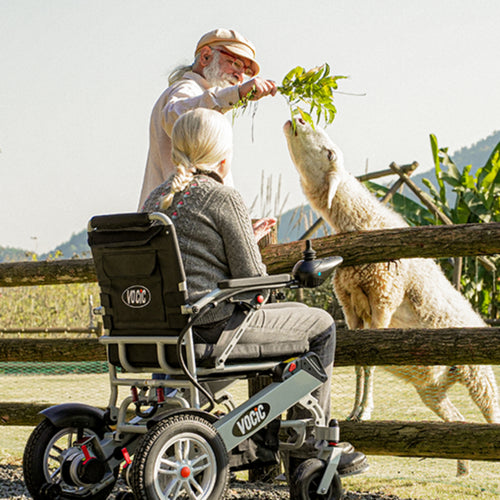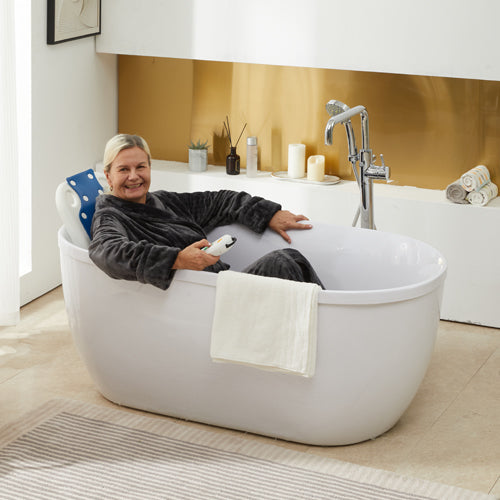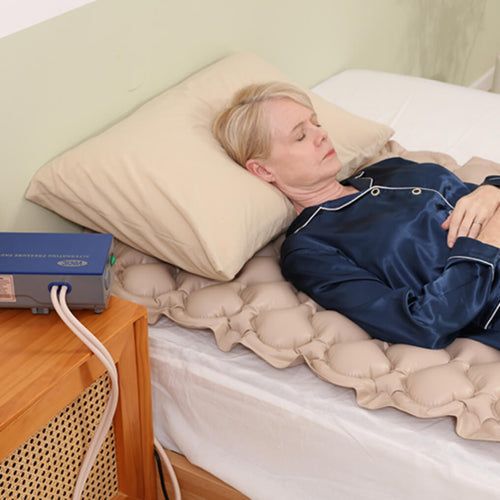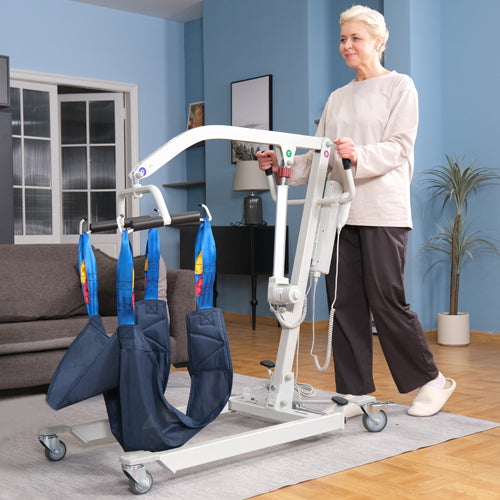Falls in older adults are serious and can result in fractures, long-term complications, and even death. Aging weakens bones and slows recovery, and even minor falls can be life-threatening. Knowing how to respond, seeking medical or assistive device help, and planning for future fall prevention can make a big difference in your loved one’s safety and recovery.
Here are some ways you can be prepared and take effective action if your loved one falls.
What Should You Do After a Parent Falls?
If your parent falls and you need to react immediately, there are three very important things you must remember.
Stay Calm and Assess the Situation: You need to stay calm and ask your parent how they are feeling and check for any obvious injuries such as cuts, bruises, or pain. If they are in severe pain or show signs of a head injury, call 911 immediately.
Avoid Rushing to Move Them: If there are obvious injuries or suspected fractures, do not try to move them. Wait for medical professionals to arrive.
Carefully Help Them Stand Up: If your parent feels able to stand, guide them slowly. Or, with the mobility aids of an aid and your support, help them stand up and sit in a safe place to rest.
When to Seek Professional Help After a Fall?
You should seek professional help immediately if your parent has severe pain, difficulty moving, or visible swelling after a fall. Additionally, if they hit their head, become confused, or show signs of drowsiness, it could indicate a concussion or internal injury, which requires urgent medical attention.
Even if they appear unharmed, it's important to consult a doctor if they have conditions like osteoporosis or if the fall has led to new balance issues. Prompt medical evaluation can prevent hidden complications and ensure your parent gets the right care.
6 Things to Ask Your Parent’s Doctor After a Fall
When an elderly parent falls, it can be a traumatic event for the entire family, raising concerns about their overall health and future care needs. Here are some questions you should ask your doctor after a parent falls:
Possible Medical Conditions: Ask if your parent has any health issues, like heart disease or diabetes, that may have triggered weakness or dizziness. Understanding these conditions can help you manage your risk of falling.
Medication Side Effects: Discuss whether any of their medications could cause balance problems or dizziness. You might need to adjust dosages or switch to safer alternatives.
Balance or Mobility Concerns: Find out if conditions like arthritis or muscle weakness are making it hard for them to stay steady. You could consider physical therapy to strengthen their mobility.
Vision Problems: Check if poor vision contributed to the fall. If necessary, schedule an eye exam to see if updated prescriptions or other vision treatments are needed.
Cognitive Factors: Ask if memory loss or confusion might be affecting their safety. Understanding this will help you decide if extra supervision or home adjustments are needed.
Orthostatic Hypotension: Determine if sudden drops in blood pressure are causing lightheadedness. You may need to make lifestyle changes or consult about medication options to improve their stability.
Symptoms to Look for After a Fall Elderly?
When an elderly person falls, some injuries may not show up immediately but may appear after a few days or the next day. Therefore, you need to pay special attention to the following symptoms:
-
Pain or Swelling: Look for any pain, especially in areas like the hips or wrists, as this can indicate fractures or sprains. Even mild pain can worsen over time, so monitor it closely.
-
Dizziness or Confusion: These symptoms could suggest a head injury or dehydration, especially if the fall was sudden. Check for ongoing dizziness or confusion, which may appear hours later.
-
Difficulty Moving Limbs or Joints: If there’s stiffness or trouble moving, it may indicate a strain, sprain, or fracture. Limited mobility is a sign of seeking medical guidance.
-
Bruising or Skin Discoloration: Bruising on the back, hips, or legs could mean an internal injury. Watch for changes in bruise color or size, as this may signal deeper issues.
-
Changes in Breathing or Heart Rate: Rapid breathing, weakness, or unusual sweating could indicate an internal injury or stress response. Persistent symptoms warrant immediate medical attention.

What Are Essential Assistive Tools for Fall Recovery?
Several assistive tools are available to help seniors recover safely after a fall, as well as to prevent future incidents. Here are some of the most helpful:
-
Maidesite Heavy Duty Floor Lift Chair: The Maidesite Chair Lift is a motorized device that helps seniors get up from the floor. It has a hand controller, dual armrests, and a stable design to provide controlled assistance. If you have a lift chair at home, you can use it to help seniors transition from sitting to standing after a fall.
-
Lifting Cushion: This is an inflatable cushion that you place under the senior. By slowly inflating, the cushion gently lifts the senior into a sitting position, taking pressure off both you and the senior, and preventing further injury.
-
Powered Lift Chair: If you have a powered lift chair at home, you can move it to where the senior fell and help them sit safely. The chair can then be gradually raised to allow them to stand up, perfect for those who are mobile but need support.
-
Transfer Belt: A transfer belt is a padded belt that you can secure around the senior's waist to provide stable support as they stand up. It typically has multiple handles, making it easier to guide them from a kneeling position to a standing position.
-
Handrails: If handrails or support handles are nearby, these stationary aids can provide a stable point of support. Handrails can be installed in high-risk areas, such as bathrooms, bedrooms, and hallways, allowing people to use them for extra balance while standing.
-
Walker: If a walker is nearby, keep it within reach to provide support as they stand up from a sitting position. 4 wheel walkers with brakes and seats can help people who need stable support after a fall.
How Does the Maidesite Electric Lift Chair Help the Elderly Stand Up Safely?
If the senior citizen has no signs of serious injury, you can use the Maidesite Heavy Duty Floor Lift Chair to help the senior citizen stand up.
Position the Chair near the Senior
Move the Maidesite Lift Chair close to the person on the floor, making sure the chair is on a flat, stable surface with plenty of space around it. Double-check that all wheels are locked, or that the chair is stable (if the chair is supposed to remain stationary), to ensure it does not wobble during the lift.
Help Them Get Seated in the Chair
Gently support them as you guide them to the seat of the chair. Place your hands on their shoulders and lower back for stability, or under their arms as needed, making sure they are not straining or exerting too much force.
Fasten the Seat Belt for Stability
Once they are comfortably seated, secure the provided seat belt around their torso or hips, depending on the design of the chair. The seat belt should fit snugly but not too tight, for comfort and stability.
Encourage Them to Use the Armrests
Ask the seniors to place their hands on the chair's double armrests for added stability. If they have arthritis or limited hand strength, gently guide their hands to the armrests and encourage them to hold on firmly but not too tightly.
Operate the Lift Slowly and Carefully
Using the hand controls, begin the lift at a slow speed to ensure comfort. Pause periodically to check if the patient is feeling uncomfortable or dizzy. Continue lifting smoothly, helping them reach an upright sitting position without sudden movements.
Guide Them from Sitting to Standing
Once the lift reaches its maximum height, help them transition to a standing position. Stand beside them and provide additional support with your hands or arms if needed. Make sure they feel balanced before releasing support. This final step allows them to stand confidently, and then you can help them walk or reach another support surface if needed.

How Mobility Aids Can Prevent Future Falls?
Mobility aids are crucial in providing elderly individuals with the stability and confidence they need to move safely. Here’s how each can help:
-
Walkers and Rollators: These devices offer four points of support, giving seniors stability and helping reduce their risk of falling. Rolled walkers with built-in seats are ideal for those who need frequent breaks or have difficulty standing for long periods.
-
Canes with Extra Grip: Canes equipped with anti-slip tips or quad bases provide increased stability, making them effective for seniors with balance issues. They’re also lightweight and easy to maneuver.
-
Stairlifts and Handrails: For seniors who struggle with stairs, stairlifts provide a safe way to move between floors. Handrails along staircases and hallways add additional support, encouraging safe movement.









